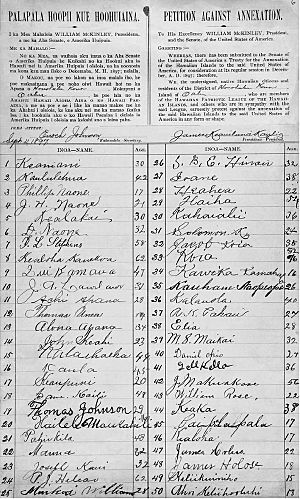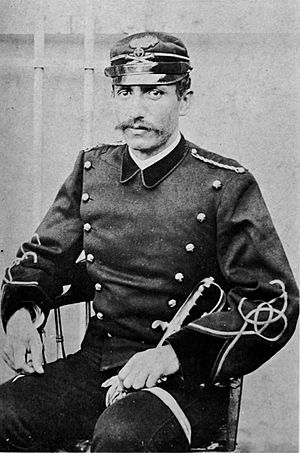Wilcox rebellions facts for kids
The Wilcox Rebellions were a series of armed uprisings in Hawaii led by Robert William Wilcox. These events happened in 1888, 1889, and 1895. Wilcox was a strong supporter of the Hawaiian monarchy. He fought against a new law called the Bayonet Constitution. This constitution took away much of the king's power. He also fought against the overthrow of the monarchy itself. Wilcox's actions were part of a larger period of Hawaiian Rebellions.
Contents
The First Wilcox Rebellion (1888)
This first rebellion was a secret plan to remove King David Kalākaua from power. The goal was to replace him with his sister, Princess Liliʻuokalani.
Why the Rebellion Happened
In 1887, there was a lot of political tension in Hawaii. A group of government ministers, led by Lorrin A. Thurston, forced King Kalākaua to sign the Bayonet Constitution. This new law greatly reduced the king's power. It also took away voting rights from many Asian residents. At the same time, it limited voting to mostly wealthy Native Hawaiians, Americans, and Europeans. Many people, especially commoners, were very unhappy with this new constitution.
Princess Liliʻuokalani and Queen Kapiolani were in Great Britain for Queen Victoria's Golden Jubilee. They quickly returned to Hawaii when they heard about the new constitution.
The Secret Plan and Its Discovery
In October 1887, Robert William Wilcox returned to Hawaii. He was a Native Hawaiian officer who had served in the Italian military. His studies in Italy had been stopped because of the new constitution.
Wilcox, Charles B. Wilson, Princess Liliʻuokalani, and Sam Nowlein secretly planned to overthrow King Kalākaua. They wanted to put Liliʻuokalani on the throne instead. They had about 300 Hawaiian supporters hidden at Iolani Barracks. They also had an alliance with the Royal Guard. However, their plan was accidentally discovered in January 1888. This was less than two days before the rebellion was supposed to start. No one was charged with a crime, but Wilcox was sent away from Hawaii. He left for San Francisco in February 1888.
Another Offer for Princess Liliʻuokalani
The group that forced the Bayonet Constitution on King Kalākaua later offered the throne to Princess Liliʻuokalani several times. However, she refused these offers. She believed she would become a powerless ruler, just like her brother.
Wilcox Rebellion of 1889
In 1889, Robert William Wilcox organized another rebellion. He wanted to bring back the monarch's full powers. This rebellion took place on July 30, 1889.
However, the rebellion failed because King Kalākaua was not at ʻIolani Palace. He was needed there to approve a new constitution. The Honolulu Rifles, an armed militia, also helped stop the rebellion. Wilcox was later tried for treason, but he was found not guilty.
The Burlesque Conspiracy (1892)
The Burlesque Conspiracy is also known as the "Sandbag Incident." The name "Burlesque" was used to make fun of Charles Wilson, the Marshal of the Kingdom. People thought he had been tricked into putting the Kingdom on high alert for no reason.
Why This Plot Happened
After Queen Liliʻuokalani became queen, some members of the National Liberal Party of the Hawaiian Kingdom felt she was not doing enough to remove the Bayonet Constitution.
Wilcox organized another plot in 1892. He formed a group called the Hawaiian Patriotic League. This group included John Edward Bush and others. Their goal was to overthrow the monarchy and create a republic.
The Sandbag Incident
Charles Wilson, the Marshal, learned about Wilcox and Bush's plans. He had agents join the group to find out what they were doing. In March 1892, Wilson was told that a coup was about to happen.
In response, he put the Kingdom on high alert. He even placed sandbags around ʻIolani Palace. This is why it was called the "Sandbag Incident." Because of this high alert, the League stopped their plan. No confrontation happened. To the public, it seemed like Wilson had overreacted, which made him look foolish. This led to the name "Burlesque Conspiracy."
What Happened Next
On May 20, Wilson raided the League. He arrested and jailed more than a dozen people, including Wilcox, for planning to overthrow the government. Wilcox spent 36 days in jail but was not convicted, so he was released.
Queen Liliʻuokalani saw this conspiracy as another sign that people wanted to get rid of the 1887 Constitution. Because of this, she later wrote the 1893 Constitution.
The 1895 Counter-Revolution
In 1895, Wilcox took part in another attempt. This time, the goal was to overthrow the Republic of Hawaii and bring Queen Liliʻuokalani back to power.
Royalist supporters secretly brought weapons and ammunition from San Francisco to Honolulu. On January 6, 1895, a group of royalists met to plan a surprise attack on government buildings. However, they had an early encounter with police, which alerted Honolulu. Their plans were quickly abandoned, and the royalists were defeated. Wilcox hid in the mountains for several days before he was captured.
During the following week, more fights happened. Many of the main plotters and their followers were captured. The government claimed to find weapons and documents at Washington Place, which was Liliʻuokalani's home. These findings seemed to connect her to the plot.
Wilcox's Continued Fight for Hawaii

A few years after his last rebellion, Robert Wilcox continued his fight for Hawaiian rights. He formed the Hawaiian Independent Party, which was later renamed the Home Rule Party. This party won most of the seats in the Legislature.
Wilcox was elected to the United States Congress. He served from November 6, 1900, to March 3, 1903. In Congress, he spoke up for Hawaiian rights and sovereignty. He was against Hawaii becoming part of the United States. However, there were disagreements between Governor Sanford B. Dole and the Home Rule Party. This made it hard for new laws to be passed. Wilcox died in the same year he left office. Today, Robert Wilcox is still seen as a hero by the Hawaiian Sovereignty Movement.


